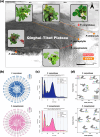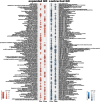Genomic data provides insights into the evolutionary history and adaptive differentiation of two tetraploid strawberries
- PMID: 39257537
- PMCID: PMC11384118
- DOI: 10.1093/hr/uhae194
Genomic data provides insights into the evolutionary history and adaptive differentiation of two tetraploid strawberries
Abstract
Over the decades, evolutionists and ecologists have shown intense interest in the role of polyploidization in plant evolution. Without clear knowledge of the diploid ancestor(s) of polyploids, we would not be able to answer fundamental ecological questions such as the evolution of niche differences between them or its underlying genetic basis. Here, we explored the evolutionary history of two Fragaria tetraploids, Fragaria corymbosa and Fragaria moupinensis. We de novo assembled five genomes including these two tetraploids and three diploid relatives. Based on multiple lines of evidence, we found no evidence of subgenomes in either of the two tetraploids, suggesting autopolyploid origins. We determined that Fragaria chinensis was the diploid ancestor of F. corymbosa while either an extinct species affinitive to F. chinensis or an unsampled population of F. chinensis could be the progenitor of F. moupinensis. Meanwhile, we found introgression signals between F. chinensis and Fragaria pentaphylla, leading to the genomic similarity between these two diploids. Compared to F. chinensis, gene families related to high ultraviolet (UV)-B and DNA repair were expanded, while those that responded towards abiotic and biotic stresses (such as salt stress, wounding, and various pathogens) were contracted in both tetraploids. Furthermore, the two tetraploids tended to down-regulate defense response genes but up-regulate UV-B response, DNA repairing, and cell division gene expression compared to F. chinensis. These findings may reflect adaptions toward high-altitude habitats. In summary, our work provides insights into the genome evolution of wild Fragaria tetraploids and opens up an avenue for future works to answer deeper evolutionary and ecological questions regarding the strawberry genus.
© The Author(s) 2024. Published by Oxford University Press on behalf of Nanjing Agricultural University.
Conflict of interest statement
The authors declare no competing interests.
Figures





Similar articles
-
Genomic analyses provide insights into sex differentiation of tetraploid strawberry (Fragaria moupinensis).Plant Biotechnol J. 2024 Jun;22(6):1552-1565. doi: 10.1111/pbi.14286. Epub 2024 Jan 6. Plant Biotechnol J. 2024. PMID: 38184782 Free PMC article.
-
Complete chloroplast genome sequencing of ten wild Fragaria species in China provides evidence for phylogenetic evolution of Fragaria.Genomics. 2021 May;113(3):1170-1179. doi: 10.1016/j.ygeno.2021.01.027. Epub 2021 Mar 8. Genomics. 2021. PMID: 33705887
-
Evolutionary origins and dynamics of octoploid strawberry subgenomes revealed by dense targeted capture linkage maps.Genome Biol Evol. 2014 Dec 4;6(12):3295-313. doi: 10.1093/gbe/evu261. Genome Biol Evol. 2014. PMID: 25477420 Free PMC article.
-
Conservation and loss of ribosomal RNA gene sites in diploid and polyploid Fragaria (Rosaceae).BMC Plant Biol. 2011 Nov 10;11:157. doi: 10.1186/1471-2229-11-157. BMC Plant Biol. 2011. PMID: 22074487 Free PMC article.
-
Fragaria: a genus with deep historical roots and ripe for evolutionary and ecological insights.Am J Bot. 2014 Oct;101(10):1686-99. doi: 10.3732/ajb.1400140. Epub 2014 Sep 17. Am J Bot. 2014. PMID: 25326614 Review.
Cited by
-
Genome-wide identification and analysis of anthocyanin synthesis-related R2R3-MYB genes in Fragaria pentaphylla.BMC Genomics. 2024 Oct 13;25(1):952. doi: 10.1186/s12864-024-10882-2. BMC Genomics. 2024. PMID: 39396954 Free PMC article.
References
-
- Soltis PS, Marchant DB, Van de Peer Y. et al. Polyploidy and genome evolution in plants. Curr Opin Genet Dev. 2015;35:119–25 - PubMed
-
- Jiao Y, Wickett NJ, Ayyampalayam S. et al. Ancestral polyploidy in seed plants and angiosperms. Nature. 2011;473:97–100 - PubMed
-
- Van de Peer Y, Mizrachi E, Marchal K. The evolutionary significance of polyploidy. Nat Rev Genet. 2017;18:411–24 - PubMed
-
- Ge S. A review of recent studies of plant systematics and evolution in China. Biodivers Sci. 2022;30:22385
Associated data
LinkOut - more resources
Full Text Sources

